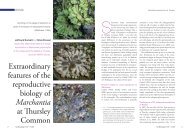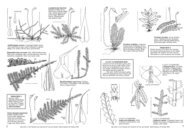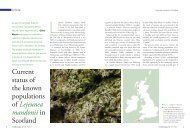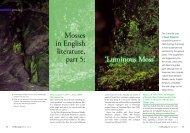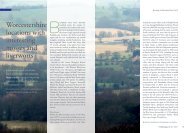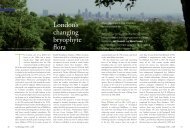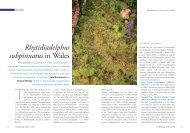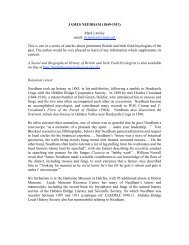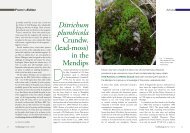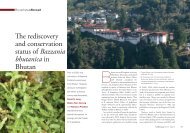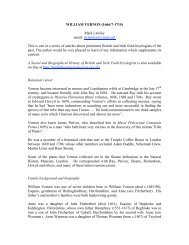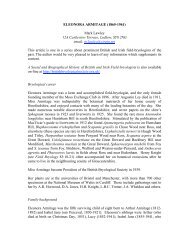Bryological Monograph An annotated checklist of the mosses of ...
Bryological Monograph An annotated checklist of the mosses of ...
Bryological Monograph An annotated checklist of the mosses of ...
You also want an ePaper? Increase the reach of your titles
YUMPU automatically turns print PDFs into web optimized ePapers that Google loves.
393. Hypnum holmenii was described from Canada,<br />
Greenland and Finland (<strong>An</strong>do, 1994), and has been<br />
found in <strong>the</strong> Arkhangelsk Oblast <strong>of</strong> Russia (Ignatov &<br />
Ignatova, 2004).<br />
394. Hypnum subimponens is reported from European<br />
Russia by Afonina (2004).<br />
395. Vesicularia sphaerocarpa (A.Jaeger) Broth. was<br />
reported from Malta by Reimers in 1934 on <strong>the</strong> basis<br />
<strong>of</strong> a 19th century collection by Schweinfurth. The<br />
specimen (B) was destroyed in <strong>the</strong> Second World War,<br />
but Reimers in Bizot & Potier de la Varde (1952) was<br />
confident that it belonged to <strong>the</strong> taxon described by<br />
<strong>the</strong>se authors as V. reimersiana. According to Corley<br />
et al. (1981), V. sphaerocarpa is a synonym <strong>of</strong> V.<br />
galerulata (Duby) Broth. Düll (1985) listed <strong>the</strong><br />
Maltese plant as V. reimersiana, but also asserted that<br />
V. galerulata had been found in mainland Italy.<br />
Corley & Crundwell (1991) accordingly added V.<br />
reimersiana to <strong>the</strong> list, retaining V. galerulata.<br />
However, no species <strong>of</strong> Vesicularia is listed for Italy<br />
by Cortini Pedrotti (2006 [2005]). It seems likely that<br />
V. galerulata has never been found in Europe.<br />
396. Smith (2004) treated Heterocladium flaccidum as a<br />
species, but provided only a nomen nudum. He has<br />
made <strong>the</strong> necessary new combination above for this<br />
<strong>checklist</strong>, noting (pers. comm. to Hill) that consultation<br />
with a number <strong>of</strong> British field bryologists revealed<br />
that, with one exception, none had encountered<br />
intermediates between it and H. heteropterum.<br />
397. Heterocladium wulfsbergii is discussed in detail by<br />
Crundwell & Smith (2000).<br />
398. Iwatsukiella leucotricha was listed for Europe by<br />
Podpěra (1954) under <strong>the</strong> name Habrodon leucotrichus<br />
(Mitt.) Perss., with a locality in <strong>the</strong> sou<strong>the</strong>rn Urals. It<br />
was omitted without comment by Corley et al.<br />
(1981), but is indicated from <strong>the</strong> European side <strong>of</strong><br />
<strong>the</strong> Urals by Dierssen (2001) and Ignatov & Ignatova<br />
(2004).<br />
399. Alpine and arctic forms <strong>of</strong> Hylocomium splendens have<br />
been variously treated. Var. alpinum Schlieph. ex<br />
Limpr. is mapped by Söderström (1996), but is<br />
doubted and treated as possibly a synonym <strong>of</strong> var.<br />
obtusifolium (Geh.) Paris by Koperski et al. (2000).<br />
Var. obtusifolium is commonly treated as a synonym<br />
<strong>of</strong> H. alaskanum (Lesq. & James) Austin, whose<br />
distinguishing characters have been shown by Ross et<br />
al. (2001) to be mainly under environmental ra<strong>the</strong>r<br />
than genetic control. It is not clear whe<strong>the</strong>r any <strong>of</strong><br />
<strong>the</strong>se forms is sufficiently distinct genetically to<br />
deserve taxonomic recognition.<br />
400. Herzogiella adscendens (Lindb.) Z.Iwats. & W.B.Sch<strong>of</strong>ield<br />
has been reported from Svalbard (Corley &<br />
Crundwell, 1991; Düll, 1985), but <strong>the</strong> record<br />
was subsequently rejected (Frisvoll & Elvebakk,<br />
1996).<br />
401. Myurella julacea var. ciliata (Chal.) Ochyra &<br />
Bednarek-Ochyra (syn. M. julacea var. scabrifolia<br />
MOSSES OF EUROPE AND MACARONESIA 243<br />
Lindb. ex Limpr.) is treated as distinct in some<br />
European countries, but intergrades completely with<br />
var. julacea. It is not recognized here.<br />
402. Ortho<strong>the</strong>cium chryseon is incorrectly listed as O.<br />
chryseum by Crosby et al. (1999). It was described as<br />
Hypnum chryseon by Schwägrichen (1804).<br />
403. Plagio<strong>the</strong>cium curvifolium is sometimes treated as a<br />
variety (in Europe) or synonym (in North America)<br />
(Ireland, 2003) <strong>of</strong> P. laetum, to which it is undoubtedly<br />
very close. As a variety, its correct name is P. laetum<br />
var. secundum.<br />
404. Plagio<strong>the</strong>cium denticulatum var. undulatum is treated<br />
in many European lists as a species, P. ru<strong>the</strong>i, but in<br />
North America merely as a synonym <strong>of</strong> P. denticulatum<br />
(Ireland, 2003). It is not clearly distinct from var.<br />
denticulatum, and we follow Ignatov & Ignatova<br />
(2004), Koperski et al. (2000) and Smith (2004) in<br />
treating it as a variety.<br />
405. Plagio<strong>the</strong>cium noricum was described from <strong>the</strong><br />
Pinzgau, Austria and was thought by Molendo<br />
(but not Limpricht) to intergrade with P. neckeroideum.<br />
Grims (1999) listed it but noted that Düll<br />
(1992) had thought it a weak species, possibly<br />
only a variety <strong>of</strong> P. neckeroideum. It is not recognized<br />
here.<br />
406. Plagio<strong>the</strong>cium succulentum is a difficult taxon,<br />
intergrading on <strong>the</strong> one hand with P. nemorale<br />
(Hemeric, 1989) and on <strong>the</strong> o<strong>the</strong>r with P. cavifolium<br />
(Nyholm, 1965). It is also very close to P. platyphyllum.<br />
It is retained here, because it cannot satisfactorily<br />
be subordinated to any <strong>of</strong> <strong>the</strong>se species without<br />
treating <strong>the</strong> whole group as a single, ra<strong>the</strong>r-broad<br />
species.<br />
407. Plagio<strong>the</strong>cium svalbardense was described by Frisvoll<br />
in Frisvoll & Elvebakk (1996).<br />
408. Pseudotaxiphyllum laetevirens was raised to species<br />
rank by Hedenäs (1992a).<br />
409. Entodon challengeri occurs in European Russia<br />
(Ignatov & Ignatova, 2004) and is <strong>the</strong> correct name<br />
for <strong>the</strong> plant formerly known as E. compressus<br />
(Iwatsuki & Tan, 2001).<br />
410. According to Ochyra & Ireland (2004), Isopterygium<br />
tenerum is absent from Europe but present in sub-<br />
Saharan Africa. However, Schumacker in Stewart<br />
(1995), Cortini Pedrotti (2006 [2005]) and Gabriel<br />
et al. (2005) list it for Italy and <strong>the</strong> Azores.<br />
Isopterygium bottinii was excluded from Sematophyllum<br />
by Guerra & Gallego (2005), and is included<br />
here in I. tenerum.<br />
411. Hageniella micans, previously known from Europe<br />
and North America, was synonymized with H.<br />
pacifica Broth., which occurs in China and Taiwan<br />
(Tan & Jia, 1999).<br />
412. Sematophyllum adnatum was found in Italy, where it is<br />
thought to be an introduction from North America<br />
(Brusa in Blockeel et al., 2000).



